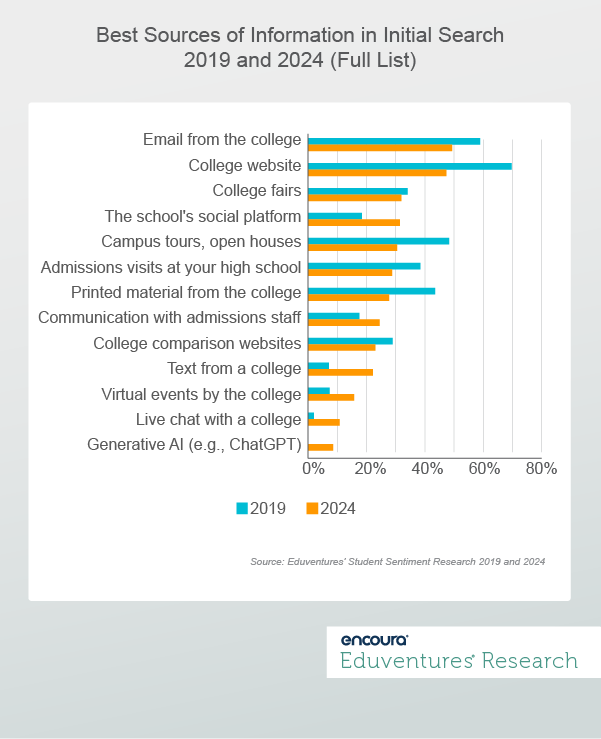The institutional website—a core reference tool for prospective students—is the hub of college search. Eduventures’ 2024 Student Sentiment Research™ shows that, among a long list of information sources, college-bound high school students place the greatest trust in a college’s website. It consistently ranks among the top three sources of information in college search.
Yet, the proportion of students who cite the website among the best sources at the top of the funnel is shrinking. What is going on?
Waning Use of Websites
Figure 1 shows the percentage of students who believe the website is among the best information sources out of a list of 14 sources (not pictured here) in 2024 and 2019—a pre-pandemic benchmark. Students were asked to rate it for three key stages of search: the initial search, the application stage, and the enrollment decision.
Figure 1.
Figure 1 shows a steep decline in students who selected the website among the best sources of information in their initial college searches, and a slightly smaller but still significant decline during the application stage. Only during the enrollment decision does the proportion of students who selected the website remain stable. Notably, in 2024, there is little difference in ratings among the three college search stages, while in 2019, ratings for the website were higher during early search.
This means that students now rate the website nearly equally across all stages of college search. Overall, it remains among the top sources, but in 2019, significantly more students rated it highly as a pre-application source of information.
Make It Quick
The key reason why students in early search are less enthusiastic about your website is revealed when we review what students had to say about institutional websites. Comments include:
- “Make it easier to go to your website. Websites are kind of weirdly complex sometimes.”
- “Easier ways to get access to information needed on college websites.”
- “Cost of tuition/housing/meal plans should be clearly shown on websites.”
In summary, students complain that it is difficult to find the information they are looking for. This matters most in early search when students look at many different institutions to assess their levels of interest and narrow down options.
At the enrollment stage, however, only a few colleges are left on the list. At this point, students have likely spent enough time on these institutions’ websites to know their way around. Additionally, perhaps they have dropped institutions with a frustrating website experience from their consideration.
It’s also important to understand that today’s prospects—currently the tail end of Gen Z— are different than those who came before them. For instance, they are less patient.
Conditioned by ubiquitous personalized content and, increasingly, by generative AI that summarizes key information quickly, these students will not engage in lengthy detective work to find what they are looking for. Rather, they will move on to the next source if they can’t find relevant information on your website. This could be your social platforms, college comparison sites, or—in the worst-case scenario—a better-designed competitor website.
Early Search
But which sources do students rely on in their initial searches if not college websites? As Figure 2 reveals, the website is still among the highest rated sources, but the gap between it and other source ratings is closing.
Figure 2.
The decline in students who chose the website as one of the best sources of information in early search coincides with an increase in ratings for other digital sources. Social platforms (+13%), texting (+15%), and virtual events (+9%) all saw an uptick in ratings for initial search during the same period. While the website still matters as an official information source, today’s prospects like to explore college options through a variety of digital sources, including a nascent interest in generative AI.
The Bottom Line
Students’ initial search behaviors are shifting to include multiple channels instead of focusing on just a handful. Institutions should follow their lead and devise a multi-channel strategy for initial campaigns. Eventually, most student searches will lead to the website, although many prospects believe that institutional websites show room for improvement.
You can start the new recruitment season with a new and improved website strategy that includes the following elements:
- Ensure your outreach channels are connected. Make sure students can easily find their way to—and from—your website. This means including links to your website in your emails, digital campaigns, text messages, and social platforms. Likewise, help students on your website access other outreach channels through links and sign-up forms.
- Improve your website experience. Once students find their way to your website, it must be user-friendly. This is often easier said than done, especially if ownership of website content is distributed. Analyze your website experience from the perspective of a prospective student. Can they easily find the information they are looking for? Can you add AI to help them answer their questions quickly?
- Ensure your website narrative addresses multiple audiences. Prospective students aren’t the only audience accessing your website. Alumni, current students, and—critically important for recruitment—prospective parents also use it. Make sure every audience has dedicated space on your website and can easily navigate to the areas that are most relevant to them.




